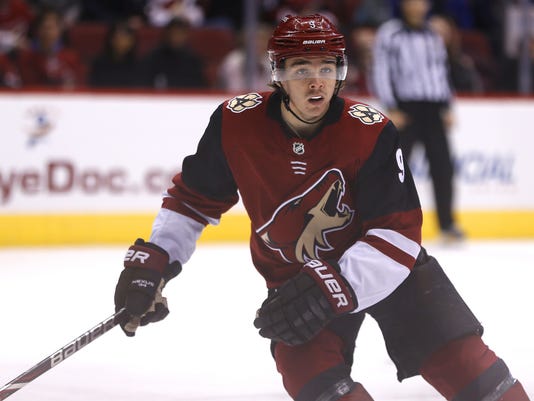Clayton Keller’s tips for 14U/16U/18U players

By Jessi Pierce, from USA Hockey
When initially posed with the question, “Has the American Development Model helped you become the player you are today?” Arizona Coyotes forward Clayton Keller’s response wasn’t quite what you’d expect.
“What exactly is that?”
Don’t blame Keller for not being up to snuff on the technical terms of USA Hockey’s sport science-based training and development philosophy. The ADM is basically all he’s known, from youth hockey in Missouri to the USA Hockey NTDP, college and beyond.
To him, it’s simply ‘hockey.’
“It was fun,” Keller said of his youth under the tutelage of 19-year NHL veteran and ADM advocate Keith Tkachuk, who coached the Chesterfield, Mo., native throughout much of his early years. “Every practice was fun. Everyone loved going to practice because we knew we were going to do this game or that game, 3-on-3 small ice, pass to the coach; little things to work on your skills, hockey IQ, being unselfish, little things like that.”
And as Keller now embarks on his second full season in the NHL, those little things he learned within the ADM have helped shape the player he is today.
Keller offered advice to 14U/16U players who are looking to make that next step.
Possess that puck
If you want to score, you have to have the puck on your stick – bottom line.
“Puck possession is huge at every level,” said Keller, who was a Calder Trophy finalist last season with 23 goals and 65 points. “You have to find ways to protect the puck. Even me as a smaller guy [at 5-foot-10, 170 pounds], I’ve always learned ways to use my body to hold possession of the puck. You watch games today and you see that some of the smaller guys are some of the best puck possession guys in the league. I think the way they use their body – Patrick Kane, Johnny Gaudreau, guys like that – they’re really fun to watch and you can learn a lot of things from them.”
Body positioning and angling are critical. Starting in youth hockey, kids learn how to develop these skills and awareness in small-area games and station-based practices.
And whether you’re 6-foot-3 or 5-foot-10 like Keller, he reminds players that size doesn’t matter.
“It’s hard to explain, but it’s really about the way you use your body,” he said. “If you have the puck on the wall, there’s ways to use your body to defend from their stick, get the puck. When you’re carrying it up the wall, similar thing, you want to have them on your back and have possession and make a move off of that. It’s also about hockey sense and hockey IQ and reading off that guy and being able to make a play.”
A step ahead with skating
NHL players work on their skating – constantly.
“Skating is such a huge part of the game that if you’re not constantly working on it, you’re not giving yourself an advantage,” said Keller, who helped Team USA to gold at the 2017 IIHF World Junior Championship with three goals and 11 points. “It’s not just all in a straight line. It’s cross-overs, it’s how you’re able to change speeds and how you are coming out of turns, little things like that you really try to work on to just get one more step on the guy to have a bigger advantage.”
At 14U/16U, players must start taking responsibility of their own development. Put in the extra work on and off the ice, which includes dryland and off-ice training to gain that edge over opponents.
Video breakdown to correct mistakes, improve IQ
One of Keller’s keys to improving is video.
“I think video is a huge part of my game,” Keller said. “After every game I try to watch every single shift and break down what I was doing and what I could have done in this position. On the power play, there are seams there that you’re looking at or little things like that in the o-zone where you should have gone, so I think video is a huge part and you can definitely learn and get a lot better with it.”
He credits video, and watching hockey in general, to increasing hockey IQ.
“It’s huge,” Keller said. “Hockey IQ is a special thing and I don’t think everyone has it. It’s something you can definitely learn I think by watching video and watching the guys in the league that have the best hockey IQ. Guys like Sidney Crosby, you see how smart he is on the ice. He’s three steps ahead of everyone else. It’s special to watch guys like that and it’s a huge part of the game today.”
Use your teammates
As one of the youngest stars in the NHL, Keller has picked the brains of veteran teammates like fellow American Derek Stepan. Leadership and camaraderie are contagious on every team, from top to bottom.
“(Stepan) is a great guy,” said Keller. “He’s been in the league a long time, and it’s great to learn from him and all the veterans I’ve met. They give you words of encouragement and help pick you up if you’ve had an off game, and they’ve helped tweak parts of my game to get better. We really help each other out and I think that’s so important. It’s a part of being teammates and developing a chemistry.”
